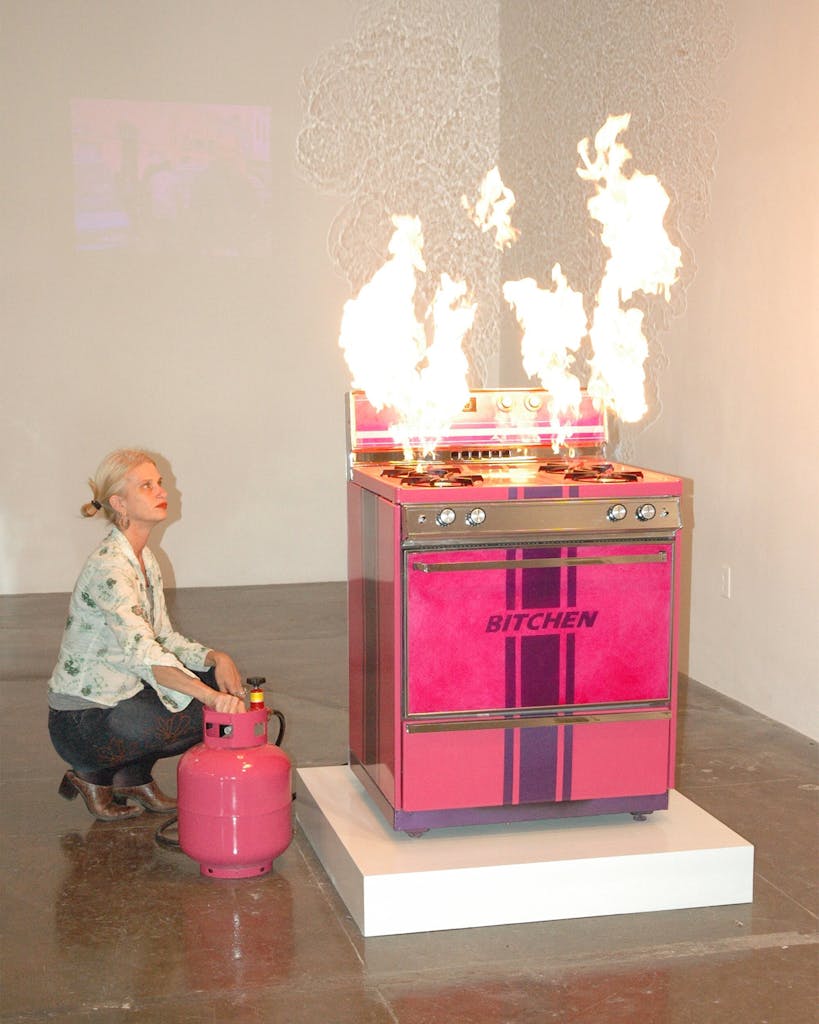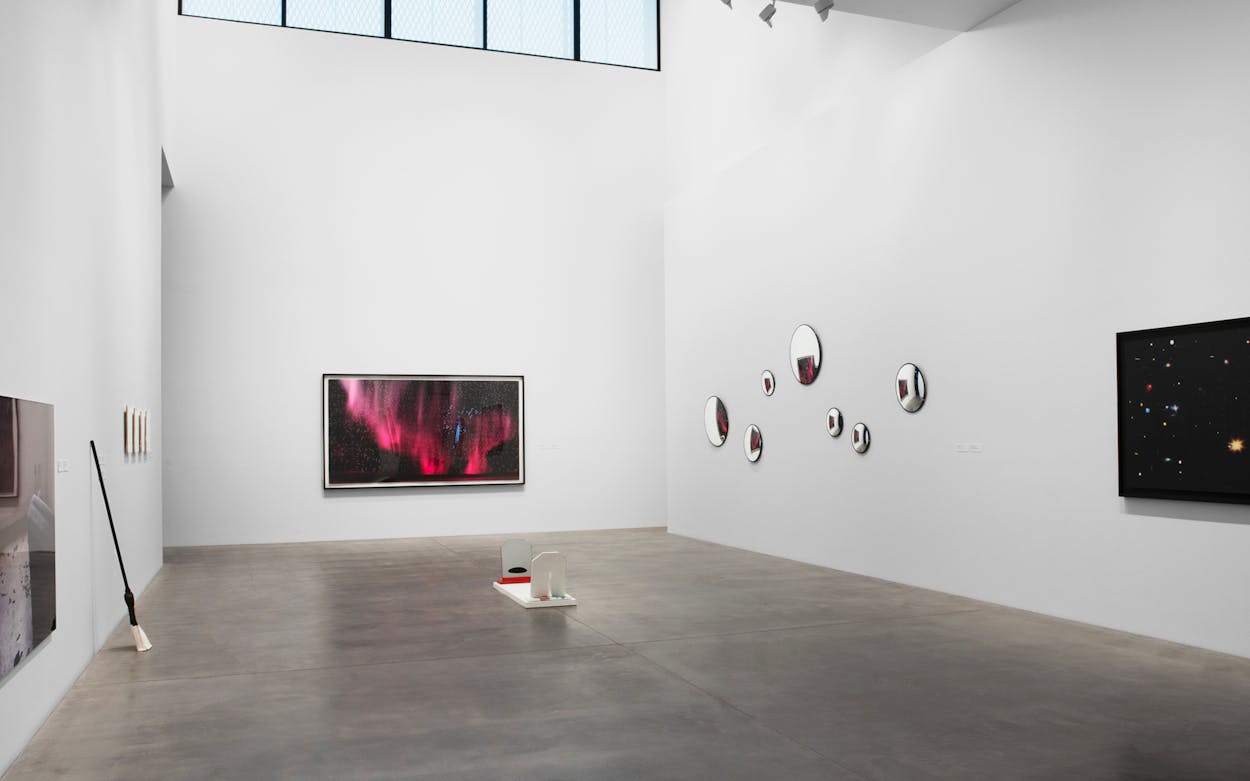On quiet days, most museums can feel a bit like ancient mausoleums, cool chambers full of precious things that once belonged to the rich and deceased. Ruby City, opened in 2019, is San Antonio’s newest, most architecturally notable, and most contemporary-focused art museum. It is also, thanks to its unusual origin story, probably the most haunted-feeling art space in Texas. The new exhibition “Tangible/Nothing,” up now through July 2023, plays into Ruby City’s otherworldly ambience with an array of conceptual artworks that deal in spectral presences and evocative absences.
Ruby City is the only museum I know of constructed according to a dream vision of a dying megacollector—the salsa heiress, art patron, and lucid dreamer Linda Pace, who died in 2007 at age 62. Ruby City was built to showcase works collected by Pace. Her tragic family life, art-world friendships, civic ambitions, and ways of seeing the world are inscribed throughout the collection, if you know how to look for them. As such, Ruby City can feel like the physical manifestation of her quirky, influential spirit.
“Tangible/Nothing” is Ruby City’s second attempt to convey the breadth of Pace’s collection through a long-running survey show that takes up much of the main building. The museum’s first main-space show, “Waking Dream,” debuted with the building’s grand opening in 2019. Where “Waking Dream” tended more toward surrealism and flights of fancy, the 35 artists of “Tangible/Nothing” are for the most part more subdued, attentive to traces of things left behind and suggestions of things barely there. For example, two straightforward but resonant pieces hang side by side near the top of the entry staircase: a Mona Hatoum piece in wax paper that is like a grave rubbing but reproduces the surface of a kitchen colander instead of a tombstone engraving, and Willie Cole’s Trance Dance I, a spiral of scorches made by an iron on stretched canvas. Both works reduce painting and printmaking to their ideal form, the physical fact of an object making its mark on a surface. Hatoum’s is delicate and Cole’s is violent, but both suggest housework and submission.

Pace was more or less raised to be an upper-crust San Antonio housewife, but she rebelled by following callings as an artist, collector, and patron, and by eventually moving downtown to an apartment that overlooks the current Ruby City site. Art that reflects on the subtle pressures of domestic life clearly appealed to her. A more maximalist work on similar themes is Katie Pell’s Bitchen Stove. Pell, a vibrant figure in the San Antonio art scene until her death in 2019—like Pace, she died relatively young from cancer—used her Bitchen series to playfully imagine a parallel reality in which women “trick out” kitchen appliances the same way car-culture men soup up their rides. Bitchen Stove is lined with fur inside the oven and can shoot jets of flame several feet in the air. A photograph of Pell demonstrating the stove hangs on the Ruby City wall next to her sculpture, in memoriam.
Nor is this the only posthumous tribute in “Tangible/Nothing.” Inside recesses in the same gallery wall, the openings covered over with sepia vellum, one makes out the forms of several shoes. This work is Atrabiliarios by Doris Salcedo, who has preserved these found-footwear items that once belonged to women who disappeared in Colombia during the country’s late–twentieth century civil conflict. In the next room, Dario Robleto, who began his career in San Antonio and now lives in Houston, contributes Candles Un-burn, Suns Un-Shine, Death Un-dies, which appears at first to resemble a Hubble Space Telescope photograph of distant galaxies. In fact, Robleto gathered the glimmers of light from album covers of recordings of live concerts by the likes of Patsy Cline, Marvin Gaye, and Bob Marley—genius popular musicians who died young. The stage lights of these long-ago shows swirl together into what we perceive as a vast and mysterious universe.
The cosmos is a major thread of “Tangible/Nothing.” Alongside Robleto’s work are other star-themed pieces, including an etching on a mirror of Pace’s birth constellation profile (a concept used in astrology) by Milagros de la Torre. Then there’s Teresita Fernández’s Night Writing (Tristan and Isolde), a depiction of the aurora borealis, or northern lights, with perforations in a pattern of Braille script, through which viewers can see glimpses of themselves in a mirror that lies behind the image. Both works call to mind the idea of finding oneself in nature or the cosmos. Fernández’s work is perhaps the most beautiful one in the exhibit, and it has a special resonance here. The artist also designed Chris Park, across the street from Ruby City, dedicated to Pace’s only son, who died of a drug overdose and whose own birth constellations are embedded in the park’s concrete walkway. These “stars” in the concrete light up at night, and Pace could look down and see them from the windows of the nearby apartment where she lived.
Ruby City’s collection in general, and “Tangible/Nothing” in particular, can feel a bit like a hall of mirrors, where everything is in some sense really a reflection of Linda Pace. Many of the works on view—such as The Bullet-Proof Piñata by David Avalos, a hanging sculpture in lead that greets visitors as they come up the stairs, or Paul Pfeiffer’s Miss America, a video of a beauty queen in which all but her crown has been retouched out of the photo, removing all possible human flaws—were Artpace commissions. (Artpace, founded by Pace in 1993, offers residencies and exhibitions in San Antonio to an ever-growing list of local and out-of-town artists.) Other artists included in “Tangible/Nothing,” like British art star du jour Cornelia Parker—who here contributes Venom and Anti-Venom, two simple paintings made with rattlesnake venom and its antidote, respectively—are former residents whom Pace continued collecting long after their Artpace sojourns.
The deeper one gets into “Tangible/Nothing,” the more the works seem to be directly about Pace. There’s a “purse portrait” of Pace’s handbag by the late San Antonio artist Chuck Ramirez. Nina Katchadourian offers photographs of Pace’s bookshelves. And Adam Schreiber fills a wall with photographs of Pace’s art collection in her otherwise-empty Camp Street apartment, taken four years after her death. In these photos, one can see some of the pieces included in “Tangible/Nothing,” but also some that didn’t make it in. One of the works you won’t be able to find, except in Schreiber’s photographs, is a colorful Gerhard Richter painting, Abstraktes Bild (774–4), which the Linda Pace Foundation controversially deaccessioned and sold for $15 million in 2014. The proceeds from that sale more or less covered the entire construction budget of the Ruby City building, according to Kelly O’Connor, head of collections at Ruby City and Pace’s former studio assistant.
In this picture of a Richter picture that no longer belongs to the museum, but without the sale of which the museum would not physically exist, we find ourselves contemplating something truly mysterious: the awesome power of money over art, and the subtler power of art to turn money into monuments and to transform a city’s culture. If nothing else, “Tangible/Nothing” will tune viewers in to those unnerving, supernatural powers, which ran through Pace and into every item on view. It’s enough to feel a chill down one’s spine, like seeing a ghost.
- More About:
- Art
- San Antonio






